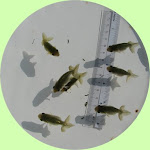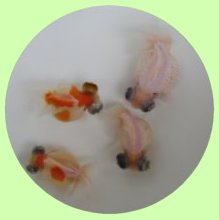Aesthetics & Engineering ~ 美學與工程學
先了解其物,才知其可愛或可恨。
~ 達芬奇
Nothing can be loved or hated, unless it is first understood.
~ Leonardo da Vinci
Reducing our aerodynamic profile by pointing our hands straight or keeping them very close to the body reduces these resistances and we glide forward easily. Now imagine that we are Ranchus trying to swim with our hands wide open to simulate the open tail fins. The stress and strained will be felt mostly on our shoulders and joints as we pushed forward (assuming if we managed to swim this way underwater).
The tail bones of the BBRs are very soft and delicate and prone to damage. We can reduce the resistance and strain on the tail fins by lowering the water level (10cm to 14cm). However, do take extra precaution on the water quality and provide good aeration because the water volume is decreased and the rate of oxygen exchange from the air stones is also reduced due to the lower water level.
The tail bones of the BBRs are very soft and delicate and prone to damage. We can reduce the resistance and strain on the tail fins by lowering the water level (10cm to 14cm). However, do take extra precaution on the water quality and provide good aeration because the water volume is decreased and the rate of oxygen exchange from the air stones is also reduced due to the lower water level.
Spawn A:
spawn date: 11 Jan 2014
video date: 24 Feb 2014
spawn date: 11 Jan 2014
video date: 24 Feb 2014
Next, imagine swimming with hands wide open and some weights tied to our abdomen to simulate a Ranchu with a full "stomach" and then, if we can, wag our hips like the peduncle of the Ranchu (just kidding). It is just common sense that we will struggle to keep our heads up against gravity and our hips may be injured due to the strains. For a Ranchu swimming with a heavy and full "stomach" and wide open tails, the strain on the back and tail core from the weight may alter their backbones, ruin their tail bones and tilt their tail dish (ozara).
 |
| A seed ranchu having damaged tail shoulder |
BBRs, like human babies need more feedings to grow and path the foundation for a healthy adult. However, overfeeding them may do them more harm than good as exemplified by the above analogy. So spread out the feedings to more moderate feeds vs a few heavy feeds to reduce the weight of the BBR and encourage them to look for more food and exercise, which in turn aids digestion and growth.
 |
| BBR with flip up tail tip on the right side and a folded tail tip on the left |
Even with these measures in place, we can only minimise but not eradicate the possibility of tail or structural damages in a BBR simply because Ranchu aesthetics defies nature: In the first place, why are we asking for a fish with beautifully spread out tail to swim and glide at ease and with good balance? Isn't the Ranchu art an amazing engineering feat? Which is precisely why the Japanese always refer to "making a Ranchu" literally. There is no perfect Ranchu and as we appreciate that it is not easy to be a Ranchu, we should try to see more of the beautiful aspect of every Ranchu and not only on its flaws :))
As I am now selling some excess BBRs in my Goldfish sales blog to most people who may be keeping the BBR for the first time, I reckoned that this blog post should come in handy in saving much repetition and making the concepts clearer ;-)
As I am now selling some excess BBRs in my Goldfish sales blog to most people who may be keeping the BBR for the first time, I reckoned that this blog post should come in handy in saving much repetition and making the concepts clearer ;-)



















